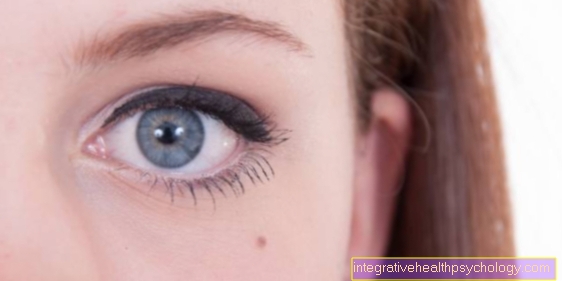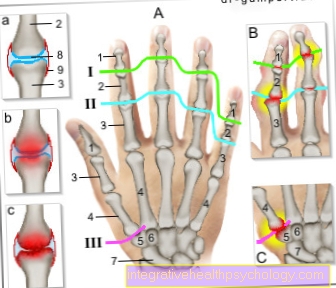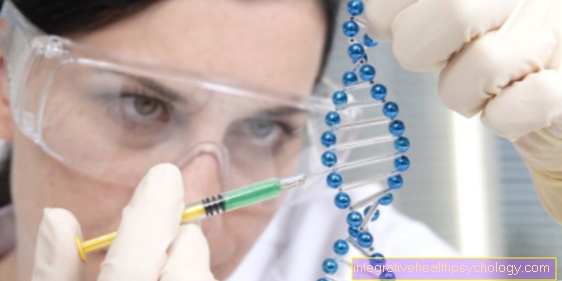Hot Flashes and Thyroid - What is the Link?
introduction
As a hormone-producing organ, the thyroid is involved in many processes in the body. In the case of under- or over-function, i.e. increased or decreased hormone production, there are many symptoms that affect the whole body.
In the case of overactive, i.e. hyperthyroidism, many sufferers develop a heat intolerance, perceived as hot flashes, with increased sweat production. Treatment can be conservative with medication as well as surgical measures.
Read more on the topic: Symptoms of an overactive thyroid

Why can thyroid disease cause hot flashes?
An overactive thyroid, also known as hyperthyroidism, means that the thyroid is producing too many hormones for a variety of reasons. The thyroid hormones are T3 and T4, with the more effective T3 being largely formed from T4 in the target cells. These hormones affect the metabolism and the cardiovascular system. When T3 is overproduced, the metabolism is boosted and this increases the body temperature. However, this is just one mechanism by which hyperthyroidism leads to hot flashes.
Read more on the topic: Hyperthyroidism
Hot flashes are often spontaneous episodes in which the heat spreads throughout the body within a few minutes and then leads to sweats. Most of these have a vasomotor cause (i.e. the movement of blood vessels). This means that for a short time the blood vessels are widened and warm blood floods the respective body area. The widening of the vessels is a measure that the body takes when the blood pressure is too high, which can also be caused by thyroid hormones. The thyroid hormones can also significantly increase the heart rate and thus also affect the circulation. The combination of these mechanisms of action often leads to the well-known hot flashes in people with an overactive thyroid.
Menopausal women are particularly badly affected, as the lack of estrogens also causes hot flashes and the effects of an overactive thyroid add up.
In addition to the direct effects on body temperature and the circulation, an overactive thyroid also leads to a changed perception of temperatures and a decrease in heat tolerance. In addition, those affected are often nervous and show increased activity. This increased activity is associated with more muscle work and can therefore also contribute to an increase in the body's heat and sweat production. In addition to hot flashes, those affected by an overactive thyroid also show many other symptoms that can be attributed to the increased metabolism. If it is severe, a diagnosis using ultrasound and laboratory tests should be carried out, as cancer of the thyroid gland can also lead to hyperthyroidism.
Further information on the subject can be found at: Hot flashes
Other accompanying symptoms
The typical symptoms of hyperthyroidism can all be traced back to the increased hormone production. Those affected suffer from restlessness, nervousness and hyperactivity. The appetite is significantly increased and those affected still lose weight. Arrhythmias and high blood pressure can occur. Women also report irregularities in their menstrual cycle. Sleep disorders are also a common symptom. Many people also suffer from hair loss and frequent bowel movements with diarrhea. The symptoms can be very different.
Racing heart
Thyroid hormones have a great effect on the cardiovascular system. As in the whole body, these hormones have an increasing effect. The heart rate is turned up significantly and can suddenly increase episodically.
Affected people can often feel this racing heartbeat themselves and thus become afraid, which increases the heart rate even further. This is often the first reason for a presentation to a doctor and thus leads to further diagnosis. The racing heart itself is not dangerous, but other cardiac arrhythmias can also occur and lead to cardiac arrest.
Read more on the topic: Thyroid hormones
Weight gain
Hyperthyroidism leads to an increased metabolic function and thus to an increased need for calories. Those affected are more likely to suffer from weight loss despite increased food intake. Weight gain is to be expected in the case of an underactive thyroid, but this is not accompanied by hot flashes. If hot flashes and weight gain are present at the same time, it is mostly the lack of estrogen during the menopause that is the cause and not the thyroid function.
You might also be interested in this topic: Symptoms of an underactive thyroid
sleep disorders
With an increased metabolic state due to an overactive thyroid, those affected often complain of restlessness and hyperactivity, which do not change even at night. Therefore, sleep disorders are a common symptom of hyperthyroidism. The hot flashes are also often to blame for poor sleep, as night sweating wakes those affected and makes it difficult to fall asleep. However, sleep disorders are a very unspecific symptom, as they occur with many diseases and can have innumerable causes.
How can it be treated?
Depending on the exact cause of the hyperthyroidism, the therapy is different. The first group of therapies are drug treatments. The production of thyroid hormones is inhibited by anti-thyroid drugs. These include the drugs thiamazole and carbimazole. However, these are not effective in the case of thyroiditis. Beta blockers can also be used for purely symptomatic purposes. These can reduce tachycardia, i.e. the racing heart.
Further information on the subject can be found at: Therapy of an overactive thyroid, treatment of an underactive thyroid
In addition to drug therapy, the thyroid gland can also be removed. Afterwards, however, those affected have to take thyroid hormones for the rest of their lives, otherwise they slip into hypofunction. An alternative to surgery is radio-iodine therapy. This radioactively destroys the thyroid tissue. This procedure cannot be used during pregnancy and breastfeeding. In the event of a thyrotoxic crisis, i.e. an acute overdose of thyroid hormones, emergency treatment must be made. It is a combination of many different drugs. These include cortisol, heparin, and fluid replacement. Those affected also need to be cooled down. Antibiotics are also used if a bacterial cause is suspected.
Read more on the topic: Thyroid Removal
Home remedies
Home remedies cannot correct the cause of hyperthyroidism, but some symptoms can be relieved. The hot flashes can be reduced by wearing loose clothing, a cool bedroom, and cool drinks or food. Relaxation therapies and sleep rituals can also help those affected.
Some people also report exercise as a helpful tool. Certain herbs such as lemon balm, wolf's foot and feverfew are also said to alleviate the symptoms and sometimes even reduce the amount of hormones. Many other foods also have an influence on the hormonal balance of the thyroid gland.
homeopathy
Hyperthyroidism is an endocrinological disease that can cause serious complications if it is not treated properly. Homeopathic remedies can only be used to support the therapy and, in the case of insomnia or hot flashes, alleviate the symptoms of some sufferers. The homeopathic remedies that are recommended are all mixed with iodine, which can help with certain causes of hyperfunction, namely the iodine deficiency goiter.
Also read the article on the topic: Iodine deficiency
When will I be healthy again?
The most common form of hyperthyroidism is Graves' disease. This is a chronic autoimmune disease. The immune reaction can be suppressed with medication, but a cure is not to be expected. After removal, the inflammation is no longer detectable, but those affected have to substitute hormones for a lifetime. An iodine deficiency goiter, which has become rare in Europe since the iodination of table salt, can be cured with the right diet. The exact duration does not need to be specified.
Read more about the here Duration of hot flashes
Prognosis for hot flashes from a thyroid gland
The prognosis for hot flashes caused by an underactive thyroid is good with daily medication.
If the hot flushes occur due to the hormonal changes during the menopause, the prognosis is very good: They disappear again after the menopause has subsided, i.e. after 3-5 years.
Recommendations from our editorial team
- Hyperthyroidism
- Graves disease
- Hypothyroidism
- Hot flashes
- Duration of hot flashes





























